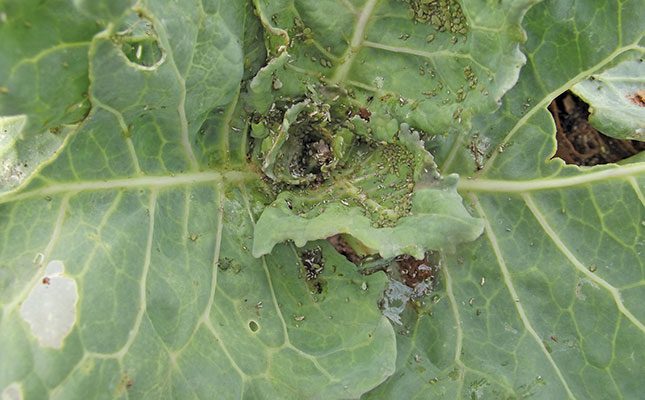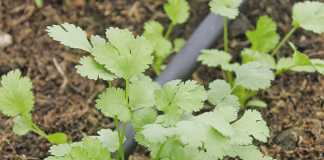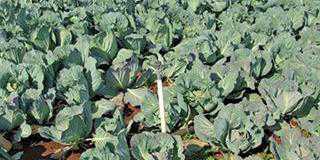
Photo: Bill Kerr
If you notice one or two cabbage plants with some aphids on their leaves, you might be tempted to dismiss this as trivial, because there is unlikely to be any physical damage at this stage. In addition, ladybirds and other predators may be present, offering some assurance of control.
The trouble is that aphids don’t only cause damage by sucking leaf sap; they are also vectors of cauliflower mosaic virus, which can result in yellow patches on the leaves and ultimately stunt the plant. If only one plant becomes heavily infected and winged aphids start to develop, the virus will spread rapidly throughout the land, with devastating results.
For this reason, aphids should not be tolerated at all, even at low populations.
Cabbage Aphid
Two species attack cabbages. By far the more common is the cabbage aphid (Brevicoryne brassicae), which can be identified by its grey waxy appearance. It’s more active in autumn and winter, but can be present all year round.
- Brassicae feeds on the underside of the leaves, causing them to curl over, which also conceals the pest. The feeding produces pale patches on the leaves, which remain throughout the life of the plant. Because the aphids are hidden in the curled-up leaves, the only way to get rid of them is to use systemic products.
Two types are available: translaminar products, which penetrate the profile of the leaf, enabling you to spray the top surface and control aphids on the underside; and fully systemic products, which move throughout the plant. The latest systemic products have a withholding period of only a few days and are safe for beneficial insects.
False Cabbage Aphid
The false cabbage aphid (Lipaphis pseudobrassicae) is green, and lacks the waxy layer seen on the cabbage aphid. It is active in warmer weather and also clusters on the underside of leaves; it does not cause leaf curling. However, because of its colour, it is harder to spot, and invariably is noticed only when the plants become stunted.
- Pseudobrassicae is often found on nursery plants, so look out for them before transplanting to the land.
This species can also be controlled with systemic or translaminar insecticides.
Aphid Predators
There are a number of aphid predators. Aphidius wasps lay a single egg in each aphid. A larva hatches and grows inside the aphid, feeding on the tissues. It then pupates into a wasp, turning the aphid carcass into a silvery grey ‘mummy’ in the process. The wasp finally chews its way out, leaving behind a telltale round hole.
Lacewing larvae, hoverfly larvae and ladybird beetles also feed on aphids.
Unfortunately, predators seldom destroy the entire population of aphids and the cauliflower mosaic virus will spread in the meantime. Moreover, the aphids will begin to move into the inner layers of the plant, where they are far more difficult to control. So speed is crucial.
I used to plant large areas to cabbage. Five weeks after transplanting, I would use a knapsack sprayer and concentrate the product on the growing point of each plant. Spraying one row at a time, I treated an average of 50 cabbages a minute, which included the time taken to fill the tank.
At this stage, aphids and diamondback moths (Plutella xylostella) were already on the plants. Using an aphicide and a product for caterpillars, I was able to get excellent control at low cost.
Bill Kerr is a vegetable specialist and breeder.












